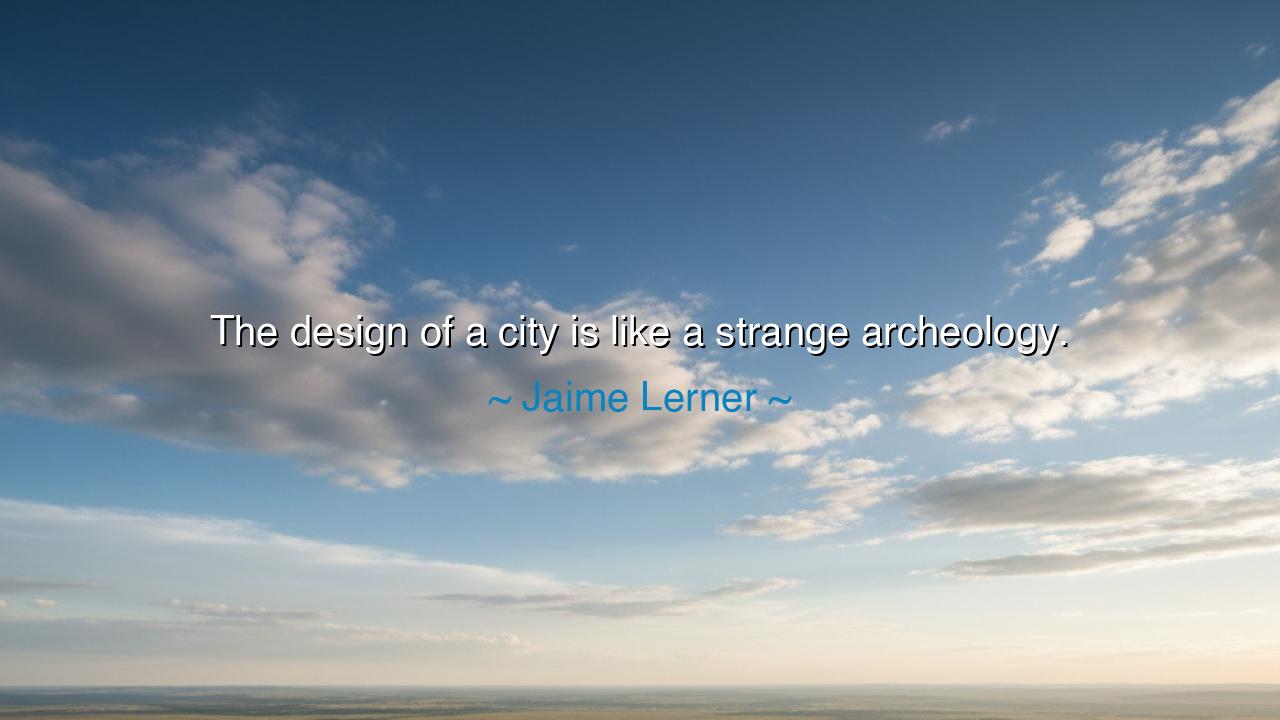
The design of a city is like a strange archeology.





“The design of a city is like a strange archeology.” Thus spoke Jaime Lerner, the visionary architect and urban planner from Brazil, whose hands shaped not only streets and buildings, but the very pulse of human life within them. His words are a riddle of profound simplicity — for in them, he reveals that every city is a living memory, a layered story of humankind written not in ink but in stone, steel, and soil. The design of a city, he tells us, is not mere geometry or utility; it is a dialogue between past and present, a map of dreams, and a mirror reflecting both the triumph and folly of civilization.
To call city design a form of archeology is to see the world with the eyes of time. For every city, from the oldest ruins to the newest skyline, is built upon the bones of those that came before. Beneath every street lies another street, beneath every building, another foundation — not only of stone, but of intention, desire, and hope. A city is never truly new; it is a palimpsest, where each generation writes its story over the traces of the last. And so, when Lerner speaks of “strange archeology,” he reminds us that to build a city is to unearth the spirit of humanity itself — to see not only what we have made, but who we have been.
Consider the ancient city of Rome. To walk its streets is to walk through the strata of two thousand years: the remnants of emperors buried beneath the hum of vespas, temples reborn as churches, aqueducts turned to modern bridges. Rome is not a monument to one age, but to all ages that dared to inhabit the same soil. Each era left its mark — not erasing, but transforming. This is the archeology of design: the understanding that a city is not built from the top down, but from the inside out, layer upon layer, memory upon memory. Rome still breathes because it was never merely constructed — it was grown, like a living organism that carries its past in every cell.
Lerner himself knew this truth deeply, for he was the architect of Curitiba, a city that became a symbol of humane urban design. When he transformed it in the late twentieth century, he did not tear down its history to impose a new order; he listened to it. He unearthed what was already there — the rhythms of the people, the flow of the land, the pulse of the streets — and from these, he sculpted a new life. Through bold ideas like bus rapid transit, public parks reclaimed from floodplains, and pedestrian-friendly avenues, he showed that the design of a city begins with understanding its hidden layers — social, cultural, and emotional — as carefully as an archaeologist studies the earth before digging. In his work, the past became the foundation of the future.
But the metaphor of archeology reaches beyond architecture. It speaks to the way all human endeavors are built upon invisible histories. Our ideas, our customs, even our fears are ruins of older worlds that lie beneath us. To design anything — a city, a community, or a life — is to excavate those hidden structures, to bring them to light, and to build anew upon their wisdom. The designer, like the archaeologist, must have patience, humility, and reverence. For to dig too quickly, or to build without understanding, is to destroy what gives the place its soul.
And so Lerner’s words are not only for architects, but for all who seek to create meaning in this world. He teaches us that progress without memory is folly, that the future must be rooted in remembrance. A city that forgets its origins becomes hollow, just as a man who denies his past loses his direction. The wise builder honors both the ruins and the dreams, seeing that one feeds the other. Every improvement, every innovation, must rise from a foundation of understanding — from knowing the layers of life that lie beneath our own.
Thus, the lesson of this quote is clear: live as a builder of continuity, not destruction. Whether you design cities or shape your own destiny, learn to listen to what came before you. Walk your streets with the eyes of an archaeologist — seeing in every corner the trace of those who lived, worked, and loved before you. Preserve what is sacred, adapt what is worn, and build with compassion for those who will inherit your creations. For when we design with remembrance, we do not merely construct — we resurrect. And in doing so, we keep alive the eternal dialogue between the earth and the human heart, between what was and what is yet to be.






AAdministratorAdministrator
Welcome, honored guests. Please leave a comment, we will respond soon